What Begins the Process of Energy Traveling Down a Neuron?
What you'll learn to do: identify the basic structures of a neuron, the function of each structure, and how letters travel through the neuron

Figure 1.Neuron in tissue culture.
Always wonder how your brain really works? What exactly is going on inside of your small, wrinkly mass while you read this text? In this section, you'll larn about the nuts of neural advice in the brain, which is the brain'south way of sending messages to and from different regions in guild to relay disquisitional data virtually your body and its environment.
Glia and neurons are the two jail cell types that make upwardly the nervous organization. While glia generally play supporting roles, the communication betwixt neurons is fundamental to all of the functions associated with the nervous system. Neuronal advice is made possible by the neuron's specialized structures, similar the soma, dendrites, axons, terminal buttons, and synaptic vesicles.
Neuronal advice is an electrochemical event. The dendrites contain receptors for neurotransmitters released by nearby neurons. If the signals received from other neurons are sufficiently strong, an action potential volition travel down the length of the axon to the terminal buttons, resulting in the release of neurotransmitters into the synapse.
Different neurotransmitters are associated with different functions. Often, psychological disorders involve imbalances in a given neurotransmitter organisation. Therefore, psychotropic drugs are prescribed in an attempt to bring the neurotransmitters back into rest. Drugs can act either every bit agonists or as antagonists for a given neurotransmitter system.
Learning Objectives
- Explain the office and role of the bones structures of a neuron
- Describe how neurons communicate with each other
- Explicate how drugs act as agonists or antagonists for a given neurotransmitter system
Neurons
Psychologists striving to sympathize the human mind may study the nervous system. Learning how the cells and organs (like the brain) function, help us understand the biological basis behind human psychology. The nervous system is composed of two basic prison cell types: glial cells (also known as glia) and neurons. Glial cells, which outnumber neurons ten to 1, are traditionally idea to play a supportive role to neurons, both physically and metabolically. Glial cells provide scaffolding on which the nervous organisation is built, assist neurons line up closely with each other to allow neuronal advice, provide insulation to neurons, ship nutrients and waste products, and mediate immune responses. Neurons, on the other hand, serve as interconnected information processors that are essential for all of the tasks of the nervous system. This section briefly describes the structure and function of neurons.
Neuron Structure
Neurons are the fundamental building blocks of the nervous organisation, 100 billion strong at nascency. Like all cells, neurons consist of several dissimilar parts, each serving a specialized function. A neuron's outer surface is made upwardly of a semipermeable membrane. This membrane allows smaller molecules and molecules without an electrical charge to pass through it, while stopping larger or highly charged molecules.
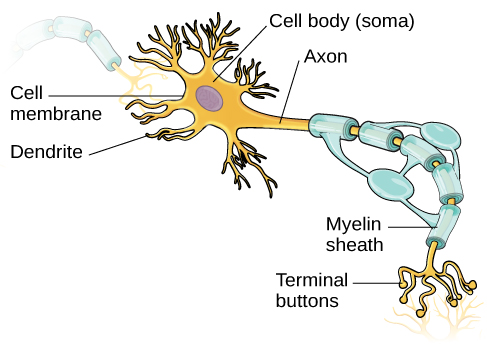
Effigy 1. This illustration shows a prototypical neuron, which is beingness myelinated.
The nucleus of the neuron is located in the soma, or cell torso. The soma has branching extensions known as dendrites. The neuron is a small data processor, and dendrites serve as input sites where signals are received from other neurons. These signals are transmitted electrically across the soma and down a major extension from the soma known as the axon, which ends at multiple concluding buttons. The terminal buttons incorporate synaptic vesicles that house neurotransmitters, the chemical messengers of the nervous organization.
Axons range in length from a fraction of an inch to several feet. In some axons, glial cells class a fatty substance known as the myelin sheath, which coats the axon and acts every bit an insulator, increasing the speed at which the signal travels. The myelin sheath is crucial for the normal functioning of the neurons within the nervous system: the loss of the insulation information technology provides tin be detrimental to normal part. To empathise how this works, permit's consider an case. Multiple sclerosis (MS), an autoimmune disorder, involves a large-calibration loss of the myelin sheath on axons throughout the nervous system. The resulting interference in the electric signal prevents the quick transmittal of data by neurons and can atomic number 82 to a number of symptoms, such as dizziness, fatigue, loss of motor control, and sexual dysfunction. While some treatments may assistance to alter the course of the illness and manage certain symptoms, there is currently no known cure for multiple sclerosis.
In healthy individuals, the neuronal signal moves rapidly down the axon to the concluding buttons, where synaptic vesicles release neurotransmitters into the synapse. The synapse is a very minor space between two neurons and is an important site where advice between neurons occurs. Once neurotransmitters are released into the synapse, they travel beyond the pocket-sized space and demark with respective receptors on the dendrite of an side by side neuron. Receptors, proteins on the cell surface where neurotransmitters attach, vary in shape, with different shapes "matching" different neurotransmitters.
Sentry It
This video shows the structure and physiology of a neuron.
How does a neurotransmitter "know" which receptor to bind to? The neurotransmitter and the receptor have what is referred to as a lock-and-key human relationship—specific neurotransmitters fit specific receptors like to how a key fits a lock. The neurotransmitter binds to whatever receptor that information technology fits.
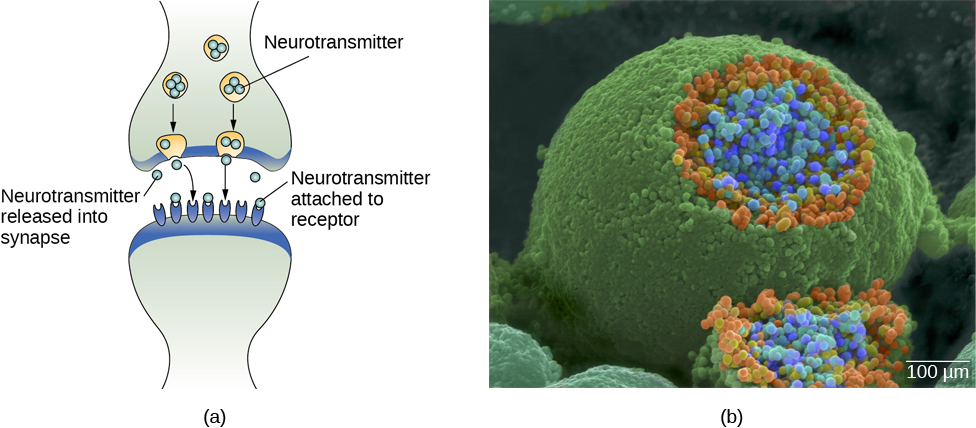
Figure 2. (a) The synapse is the space between the terminal button of 1 neuron and the dendrite of another neuron. (b) In this pseudo-colored epitome from a scanning electron microscope, a final button (green) has been opened to reveal the synaptic vesicles (orangish and blueish) inside. Each vesicle contains about x,000 neurotransmitter molecules. (credit b: modification of work by Tina Carvalho, NIH-NIGMS; scale-bar data from Matt Russell)
Try It
Now that we accept learned about the bones structures of the neuron and the office that these structures play in neuronal communication, permit's take a closer await at the point itself—how information technology moves through the neuron and so jumps to the side by side neuron, where the procedure is repeated.
We begin at the neuronal membrane. The neuron exists in a fluid environment—it is surrounded past extracellular fluid and contains intracellular fluid (i.eastward., cytoplasm). The neuronal membrane keeps these 2 fluids separate—a critical office because the electrical signal that passes through the neuron depends on the intra- and extracellular fluids being electrically dissimilar. This difference in accuse across the membrane, called the membrane potential, provides energy for the betoken.
The electric charge of the fluids is caused by charged molecules (ions) dissolved in the fluid. The semipermeable nature of the neuronal membrane somewhat restricts the movement of these charged molecules, and, every bit a outcome, some of the charged particles tend to become more than concentrated either inside or outside the jail cell.
Between signals, the neuron membrane'southward potential is held in a land of readiness, called the resting potential. Like a rubber band stretched out and waiting to jump into action, ions line upward on either side of the cell membrane, ready to rush across the membrane when the neuron goes agile and the membrane opens its gates (i.eastward., a sodium-potassium pump that allows movement of ions across the membrane). Ions in high-concentration areas are ready to motility to low-concentration areas, and positive ions are ready to move to areas with a negative charge.
In the resting state, sodium (Na+) is at college concentrations outside the cell, so it volition tend to move into the jail cell. Potassium (K+), on the other hand, is more than concentrated inside the cell, and volition tend to move out of the jail cell (Figure iii). In improver, the inside of the prison cell is slightly negatively charged compared to the outside. This provides an boosted strength on sodium, causing information technology to move into the cell.
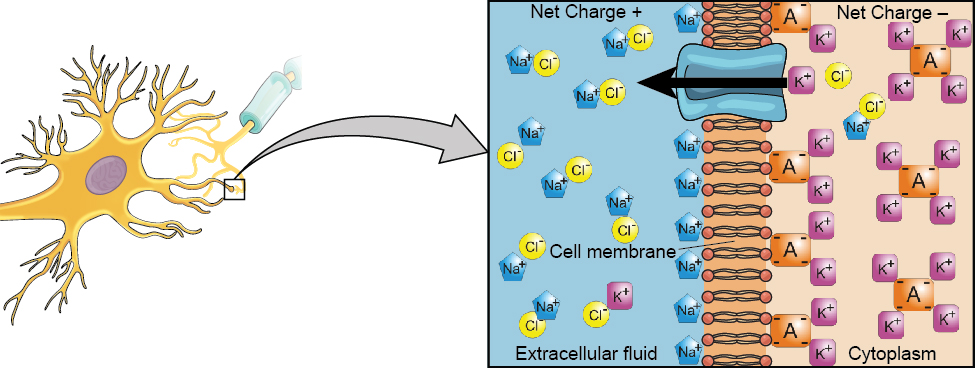
Figure 3. At resting potential, Na+ (blue pentagons) is more highly concentrated exterior the cell in the extracellular fluid (shown in blue), whereas 1000+ (purple squares) is more than highly concentrated most the membrane in the cytoplasm or intracellular fluid. Other molecules, such equally chloride ions (yellow circles) and negatively charged proteins (brownish squares), help contribute to a positive cyberspace accuse in the extracellular fluid and a negative internet charge in the intracellular fluid.
From this resting potential state, the neuron receives a signal and its land changes abruptly (Figure 4). When a neuron receives signals at the dendrites—due to neurotransmitters from an next neuron binding to its receptors—pocket-size pores, or gates, open up on the neuronal membrane, allowing Na+ ions, propelled by both accuse and concentration differences, to move into the jail cell. With this influx of positive ions, the internal accuse of the cell becomes more than positive. If that charge reaches a certain level, called the threshold of excitation, the neuron becomes active and the action potential begins. This process of when the cell's accuse becomes positive, or less negative, is called depolarization.
Many additional pores open, causing a massive influx of Na+ ions and a huge positive spike in the membrane potential, the peak activeness potential. At the meridian of the spike, the sodium gates close and the potassium gates open. As positively charged potassium ions leave, the cell quickly begins repolarization. At first, it hyperpolarizes, condign slightly more negative than the resting potential, so it levels off, returning to the resting potential.
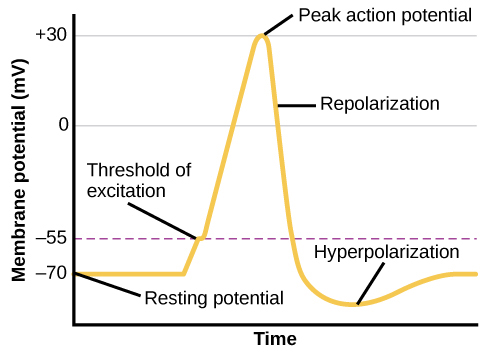
Figure 4. During the activeness potential, the electrical charge across the membrane changes dramatically.
This positive fasten constitutes the activity potential: the electric signal that typically moves from the cell body down the axon to the axon terminals. The electrical signal moves downwards the axon similar a wave; at each betoken, some of the sodium ions that enter the cell diffuse to the next department of the axon, raising the charge past the threshold of excitation and triggering a new influx of sodium ions. The activeness potential moves all the way downwards the axon to the terminal buttons.
Watch It
The process of neural communication is explained in the post-obit video.
The activity potential is an all-or-none phenomenon. In simple terms, this ways that an incoming signal from another neuron is either sufficient or bereft to achieve the threshold of excitation. There is no in-between, and at that place is no turning off an action potential once it starts. Recollect of it like sending an email or a text message. You tin think well-nigh sending information technology all you want, just the message is not sent until you lot hitting the send button. Furthermore, in one case yous ship the message, there is no stopping it.
Because it is all or none, the action potential is recreated, or propagated, at its full force at every point along the axon. Much similar the lit fuse of a firecracker, information technology does not fade away as information technology travels down the axon. It is this all-or-none property that explains the fact that your brain perceives an injury to a afar torso part like your toe as equally painful equally i to your nose.
Every bit noted earlier, when the action potential arrives at the last button, the synaptic vesicles release their neurotransmitters into the synapse. The neurotransmitters travel across the synapse and bind to receptors on the dendrites of the adjacent neuron, and the process repeats itself in the new neuron (bold the signal is sufficiently potent to trigger an action potential). In one case the point is delivered, excess neurotransmitters in the synapse migrate abroad, are cleaved downward into inactive fragments, or are reabsorbed in a process known as reuptake. Reuptake involves the neurotransmitter being pumped dorsum into the neuron that released it, in order to articulate the synapse (Effigy v). Clearing the synapse serves both to provide a clear "on" and "off" state between signals and to regulate the production of neurotransmitter (full synaptic vesicles provide signals that no additional neurotransmitters need to be produced).
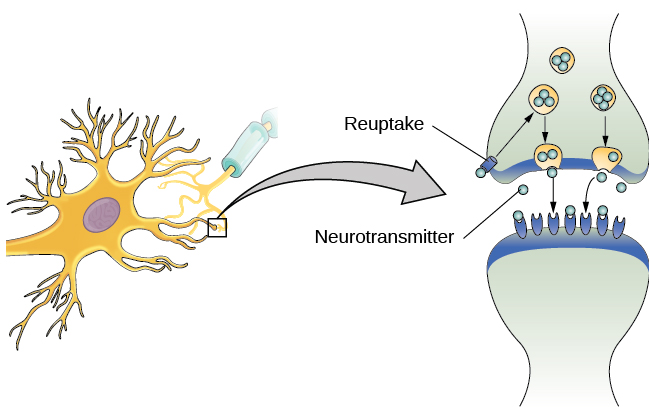
Figure 5. Reuptake involves moving a neurotransmitter from the synapse dorsum into the axon terminal from which it was released.
Neuronal communication is often referred to equally an electrochemical upshot. The move of the activity potential down the length of the axon is an electrical event, and motility of the neurotransmitter across the synaptic space represents the chemical portion of the procedure.
Endeavor It
Watch It
Watch the following video to encounter how neurons communicate inside the body.
Neurotransmitters and Drugs
There are several different types of neurotransmitters released past different neurons, and nosotros can speak in broad terms about the kinds of functions associated with different neurotransmitters (Table i). Much of what psychologists know most the functions of neurotransmitters comes from research on the furnishings of drugs in psychological disorders. Psychologists who accept a biological perspective and focus on the physiological causes of beliefs assert that psychological disorders similar depression and schizophrenia are associated with imbalances in one or more neurotransmitter systems. In this perspective, psychotropic medications tin help ameliorate the symptoms associated with these disorders. Psychotropic medications are drugs that treat psychiatric symptoms by restoring neurotransmitter balance.
| Neurotransmitter | Involved in | Potential Consequence on Behavior |
|---|---|---|
| Acetylcholine | Muscle action, memory | Increased arousal, enhanced noesis |
| Beta-endorphin | Pain, pleasure | Decreased feet, decreased tension |
| Dopamine | Mood, slumber, learning | Increased pleasure, suppressed appetite |
| Gamma-aminobutyric acid (GABA) | Brain function, sleep | Decreased anxiety, decreased tension |
| Glutamate | Memory, learning | Increased learning, enhanced retentivity |
| Norepinephrine | Heart, intestines, alacrity | Increased arousal, suppressed appetite |
| Serotonin | Mood, slumber | Modulated mood, suppressed appetite |
Psychoactive drugs can deed every bit agonists or antagonists for a given neurotransmitter system. Agonists are chemicals that mimic a neurotransmitter at the receptor site and, thus, strengthen its effects. An antagonist, on the other paw, blocks or impedes the normal activity of a neurotransmitter at the receptor. Agonist and antagonist drugs are prescribed to correct the specific neurotransmitter imbalances underlying a person'south condition. For example, Parkinson'due south disease, a progressive nervous system disorder, is associated with low levels of dopamine. Therefore dopamine agonists, which mimic the effects of dopamine by binding to dopamine receptors, are one handling strategy.
Certain symptoms of schizophrenia are associated with overactive dopamine neurotransmission. The antipsychotics used to treat these symptoms are antagonists for dopamine—they cake dopamine'due south effects by binding its receptors without activating them. Thus, they prevent dopamine released past i neuron from signaling information to side by side neurons.
In dissimilarity to agonists and antagonists, which both operate past bounden to receptor sites, reuptake inhibitors foreclose unused neurotransmitters from being transported back to the neuron. This leaves more neurotransmitters in the synapse for a longer time, increasing its effects. Depression, which has been consistently linked with reduced serotonin levels, is normally treated with selective serotonin reuptake inhibitors (SSRIs). By preventing reuptake, SSRIs strengthen the issue of serotonin, giving it more than fourth dimension to collaborate with serotonin receptors on dendrites. Common SSRIs on the market place today include Prozac, Paxil, and Zoloft. The drug LSD is structurally very similar to serotonin, and information technology affects the same neurons and receptors as serotonin. Psychotropic drugs are non instant solutions for people suffering from psychological disorders. Often, an individual must take a drug for several weeks before seeing improvement, and many psychoactive drugs have significant negative side effects. Furthermore, individuals vary dramatically in how they respond to the drugs. To improve chances for success, it is not uncommon for people receiving pharmacotherapy to undergo psychological and/or behavioral therapies likewise. Some research suggests that combining drug therapy with other forms of therapy tends to be more effective than whatsoever one treatment alone (for one such example, see March et al., 2007).
Try Information technology
Watch It
Review the process of neural communication in the following CrashCourse psychology video:
Glossary
action potential:electrical signal that moves down the neuron'southward axon
agonist:drug that mimics or strengthens the furnishings of a neurotransmitter
all-or-none:phenomenon that incoming indicate from another neuron is either sufficient or insufficient to reach the threshold of excitation
adversary:drug that blocks or impedes the normal action of a given neurotransmitter
axon:major extension of the soma
biological perspective:view that psychological disorders like depression and schizophrenia are associated with imbalances in i or more than neurotransmitter systems
dendrite:co-operative-similar extension of the soma that receives incoming signals from other neurons
depolarization: when a jail cell'southward charge becomes positive, or less negative
glial prison cell:nervous system prison cell that provides concrete and metabolic support to neurons, including neuronal insulation and communication, and food and waste matter transport
hyperpolarization:when a cell's charge becomes more negative than its resting potential
membrane potential:divergence in charge across the neuronal membrane
myelin sheath:fatty substance that insulates axons
neuron:cells in the nervous system that human activity every bit interconnected data processors, which are essential for all of the tasks of the nervous arrangement
neurotransmitter:chemic messenger of the nervous system
psychotropic medication:drugs that treat psychiatric symptoms past restoring neurotransmitter balance
receptor:protein on the cell surface where neurotransmitters adhere
resting potential:the state of readiness of a neuron membrane's potential between signals
reuptake:neurotransmitter is pumped back into the neuron that released information technology
semipermeable membrane:cell membrane that allows smaller molecules or molecules without an electrical charge to pass through it, while stopping larger or highly charged molecules
soma:cell body
synapse:small gap between two neurons where advice occurs
synaptic vesicle:storage site for neurotransmitters
terminal button:axon terminal containing synaptic vesicles
threshold of excitation:level of charge in the membrane that causes the neuron to go agile
0 Response to "What Begins the Process of Energy Traveling Down a Neuron?"
Post a Comment